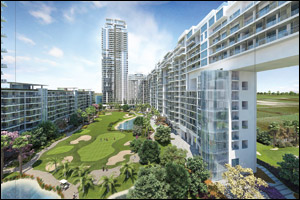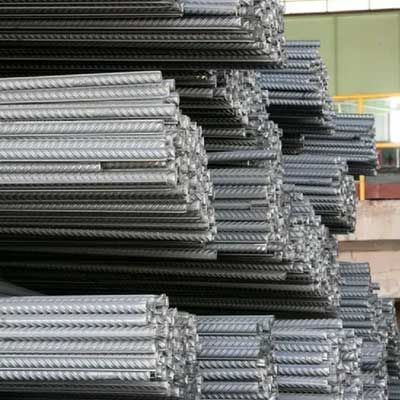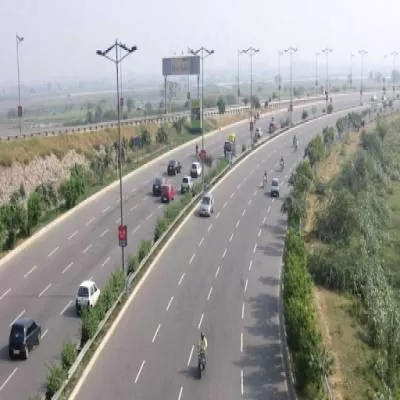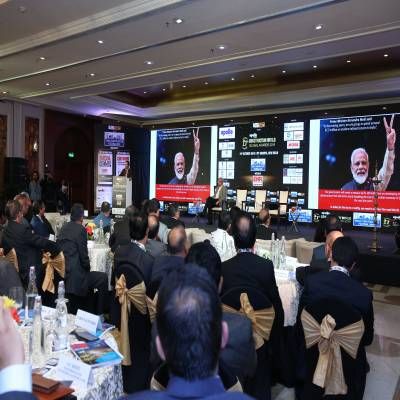- Home
- Infrastructure Transport
- ROADS & HIGHWAYS
- We have been a debt-free company

We have been a debt-free company
Its innovative, unique and unparalleled concepts have enabled it to attain a league of its own. Established over 15 years ago, M3M Group, a developer in Delhi-NCR, has been on a mission to deliver high-end living with niche standards of professionalism, ethics, quality, service and taste. In 2010, the company, which owns over 500 acre in Gurgaon, Delhi and NCR, launched a 75-acre premium luxury group-housing project on Golf Course Extension Road in Gurgaon, with plans to develop 1,700 units on site. Its project portfolio ranges across ultra luxury residential, premium residential, retail, commercial, super luxury service apartments and five-star luxury hotels. Pankaj Bansal, Director, M3M India, speaks to MONISHA RAO about the company´s ongoing projects and real-estate market in the NCR.
What is the company´s main area of specialisation?
M3M specialises in total property development through conceptual development, construction and marketing. The total value of our projects on a year-on-year basis is Rs 4,000 crore with around Rs 1,000 crore of investment in the residential segment on the cards. With 70 per cent of our operations streamlined in the residential area, we are also gaining ground in the commercial and real-estate segment.
Give us an insight into your operations.
Our flagship project, Golf Estate, is spread across 75 acre of prime land on Golf Course Road. We also have residential projects Escala and Woodshire that are under development in the Dwarka Expressway area. Further, we have made a foray into the commercial segment with projects like Urbana and Cosmopolitan. These offer service apartments and hotels within a commercial complex. We primarily deliver luxury projects with the help of professionals who lay strict emphasis on quality construction.
Property prices in prime locations in South Delhi have fallen by 15 per cent. How has this affected your company?
There has been no dip in property prices in the luxury segment, which is our forte. The market for the elite is not dependent on external or internal economic conditions. The market price in the high-end segment is close to Rs 13,000-14,000 per sq ft and commercial is about Rs 9,000 per sq ft.
Luxury unit sales in Delhi have also gone up by 25 per cent in the current fiscal.
What impact has this had on your operations in the luxury segment?
As we cater to a very select and limited audience, we have fairly decent demand. Our project called Polo Suites, which offers apartments of 5,000 sq ft, has fetched significant numbers from the market. The limited and small size of the luxury market works in our favour, with huge growth potential in the future.
Tell us more about the Polo Suites project.
As a part of the Golf Estate project, Polo Suites have been thematically planned, drawing inspiration from the sport, polo. With apartments, horses and a polo concierge service, the project gets the customer associated with the global polo fraternity, with exclusive participation in all polo activities. It is a very interesting concept developed with Adiraj Singh, the Arjuna Award-winning polo player. We have received tremendous response to this project.
A lot of new launches are limited to a few pocket areas in the city. What areas in Delhi are the most responsive in terms of generating maximum revenue?.
Gurgaon, Golf Course Extension and the Sona Road area have, over the years, evolved to become popular areas with the high-end of the market. Areas around Dwarka Expressway and centre of Noida are also good to invest in. However, Faridabad and Ghaziabad are still to catch up in the market.
How have rising construction prices affected your business?
We have fortunately been a debt-free company. We have managed with our investments but, yes, it is worrying. Increase in construction costs is bound to have an effect on all development activities in the city. Ultimately, the question is how much margin can be squeezed in such circumstances û will it be passed on to the customer immediately or gradually? However, I do not think a developer can keep squeezing margins as nobody makes a project with a loss. Something needs to be done about it.
Any suggestions?
The government will have to look at the import export policy; this could allow import or giving subsidies and advantages for steel and cement industry, such as not taxing them regularly so that they do not pass it on and increase prices. It is a macro issue that defies an easy solution. Answers have to come from a government policy and overall macroeconomic outlook regarding development and the infrastructure industry.
With advancement in technology, what new techniques are being used to construct buildings?
Value engineering is the new buzzword and professionals are playing a big part in advising us on techniques, equipment and technology from overseas to build faster and less expensive structures; it´s a move towards more economical and environment-friendly construction. Trends include the use of fly ash, pre-fabricated components and the latest technologies in flooring. More professional builders have already started adopting these technologies and techniques. But newer builders who do not have experience are still going the old-fashioned way. Initially, it took a long time for radial tyres to be accepted because people found them very expensive now, you cannot find a normal tyre anymore! Transfer of technology takes time but eventually happens once the benefits become apparent. Quality can only improve, speed will increase fivefold and it will be much faster to deliver the goods. It will make the industry more professional and mature.
How has the market responded?
More professional builders have already started adopting these technologies and techniques. But newer builders who do not have experience are still going the old-fashioned way. Initially, it took a long time for radial tyres to be accepted because people found them very expensive now, you cannot find a normal tyre anymore! So transfer of technology takes time but eventually happens once the benefits become apparent. Quality can only improve, speed will increase fivefold and it will be much faster to deliver the goods. It will make the industry more professional and mature.
How different are the Mumbai and Delhi NCR real-estate markets?
In Mumbai, there is no space, so it is all a vertical market and more expensive because land prices are much higher. One would have to play with different figures there and profitability comes from a higher price. In Mumbai, I would certainly look at unused land by industrial houses and mill areas as well as slum redevelopment, which has already started. I would also look at areas in Navi Mumbai area to see how they can be developed with good connectivity to Central Mumbai.
Are you planning to expand beyond Gurgaon and Delhi?
Currently, we are operating in this area but we may move ahead to other projects too. If given a choice, Mumbai would be the next one. In Mumbai, there is no space, so it is all a vertical market and more expensive because land prices are much higher. One would have to play with different figures there and profitability comes from a higher price. I would certainly look at unused land by industrial houses and mill areas as well as slum redevelopment, which has already started. I would also look at areas in Navi Mumbai to see how they can be developed with good connectivity to Central Mumbai.
How do you view the development in Tier-II and Tier-III cities?
Initially, there was euphoria but only a few Tier II cities are doing extremely well like Lucknow and Indore. Some cities like Jaipur are doing fine. If there is political stability, I believe there will be a new resurgence; then Patna would be the next place to watch. Places like Raipur and Ranchi are coming up with a lot of malls and fairly decent housing.
The residential segment seems to have gained popularity in Tier II and Tier III cities but what is the scope for the development of commercial and retail segments in these cities?
The high-street concept is still there and there are a couple of malls. So I think the question of people getting used to the mall culture exists and it will happen. When there are more malls, the full culture would change. Until there is business, the commercial sector will always play second fiddle.
What emphasis do you lay on sustainability?
We undertake rainwater harvesting and many other environment-friendly activities. We are looking at alternative sources of power and experimenting with many things.
Your outlook for the real estate industry...
It is buoyant and maturing. But it is not a quick fix and we should not rush it. Unfortunately, it is also related to the cycle of elections. On the overall macro level, there is nothing but growth.
Fact Sheet
- Top management: Pankaj Bansal, Director, M3M India
- No. of employees: 150 plus
- Centre of operation: Delhi NCR
- Turnover: Rs.1,200 crore
- Land holding: 2,000 acre
- Total projects in Phase I: 39
- Estimated revenue potential: Rs.30,000 crore
- Projects currently under development: Seven
- Area under development: Over 11 million sq ft (built-up area)
- Year-on-year sales value turnover: Rs.4,000 crore
Green initiatives
- Fly-ash brick for masonry partition
- Use of fly ash for concrete works
- STP for recycling water
- Rainwater harvesting
- Use of double glazing for superior heat, sound insulation and energy saving
- Passive shading devices integrated in the building architecture to minimise heat gain and consequent energy saving
- Tinted glass for building glazing
- Roof insulation for minimising heat gain and increasing energy efficiency
- Solar panels for heating water and street lighting
- Intelligent programmable logic controls for building services
- for energy-efficiency
- VRV system for air-conditioning and energy-efficiency
- Aluminium glazing as a substitute for wood.
Its innovative, unique and unparalleled concepts have enabled it to attain a league of its own. Established over 15 years ago, M3M Group, a developer in Delhi-NCR, has been on a mission to deliver high-end living with niche standards of professionalism, ethics, quality, service and taste. In 2010, the company, which owns over 500 acre in Gurgaon, Delhi and NCR, launched a 75-acre premium luxury group-housing project on Golf Course Extension Road in Gurgaon, with plans to develop 1,700 units on site. Its project portfolio ranges across ultra luxury residential, premium residential, retail, commercial, super luxury service apartments and five-star luxury hotels. Pankaj Bansal, Director, M3M India, speaks to MONISHA RAO about the company´s ongoing projects and real-estate market in the NCR. What is the company´s main area of specialisation? M3M specialises in total property development through conceptual development, construction and marketing. The total value of our projects on a year-on-year basis is Rs 4,000 crore with around Rs 1,000 crore of investment in the residential segment on the cards. With 70 per cent of our operations streamlined in the residential area, we are also gaining ground in the commercial and real-estate segment. Give us an insight into your operations. Our flagship project, Golf Estate, is spread across 75 acre of prime land on Golf Course Road. We also have residential projects Escala and Woodshire that are under development in the Dwarka Expressway area. Further, we have made a foray into the commercial segment with projects like Urbana and Cosmopolitan. These offer service apartments and hotels within a commercial complex. We primarily deliver luxury projects with the help of professionals who lay strict emphasis on quality construction. Property prices in prime locations in South Delhi have fallen by 15 per cent. How has this affected your company? There has been no dip in property prices in the luxury segment, which is our forte. The market for the elite is not dependent on external or internal economic conditions. The market price in the high-end segment is close to Rs 13,000-14,000 per sq ft and commercial is about Rs 9,000 per sq ft. Luxury unit sales in Delhi have also gone up by 25 per cent in the current fiscal. What impact has this had on your operations in the luxury segment? As we cater to a very select and limited audience, we have fairly decent demand. Our project called Polo Suites, which offers apartments of 5,000 sq ft, has fetched significant numbers from the market. The limited and small size of the luxury market works in our favour, with huge growth potential in the future. Tell us more about the Polo Suites project. As a part of the Golf Estate project, Polo Suites have been thematically planned, drawing inspiration from the sport, polo. With apartments, horses and a polo concierge service, the project gets the customer associated with the global polo fraternity, with exclusive participation in all polo activities. It is a very interesting concept developed with Adiraj Singh, the Arjuna Award-winning polo player. We have received tremendous response to this project. A lot of new launches are limited to a few pocket areas in the city. What areas in Delhi are the most responsive in terms of generating maximum revenue?. Gurgaon, Golf Course Extension and the Sona Road area have, over the years, evolved to become popular areas with the high-end of the market. Areas around Dwarka Expressway and centre of Noida are also good to invest in. However, Faridabad and Ghaziabad are still to catch up in the market. How have rising construction prices affected your business? We have fortunately been a debt-free company. We have managed with our investments but, yes, it is worrying. Increase in construction costs is bound to have an effect on all development activities in the city. Ultimately, the question is how much margin can be squeezed in such circumstances û will it be passed on to the customer immediately or gradually? However, I do not think a developer can keep squeezing margins as nobody makes a project with a loss. Something needs to be done about it. Any suggestions? The government will have to look at the import export policy; this could allow import or giving subsidies and advantages for steel and cement industry, such as not taxing them regularly so that they do not pass it on and increase prices. It is a macro issue that defies an easy solution. Answers have to come from a government policy and overall macroeconomic outlook regarding development and the infrastructure industry. With advancement in technology, what new techniques are being used to construct buildings? Value engineering is the new buzzword and professionals are playing a big part in advising us on techniques, equipment and technology from overseas to build faster and less expensive structures; it´s a move towards more economical and environment-friendly construction. Trends include the use of fly ash, pre-fabricated components and the latest technologies in flooring. More professional builders have already started adopting these technologies and techniques. But newer builders who do not have experience are still going the old-fashioned way. Initially, it took a long time for radial tyres to be accepted because people found them very expensive now, you cannot find a normal tyre anymore! Transfer of technology takes time but eventually happens once the benefits become apparent. Quality can only improve, speed will increase fivefold and it will be much faster to deliver the goods. It will make the industry more professional and mature. How has the market responded? More professional builders have already started adopting these technologies and techniques. But newer builders who do not have experience are still going the old-fashioned way. Initially, it took a long time for radial tyres to be accepted because people found them very expensive now, you cannot find a normal tyre anymore! So transfer of technology takes time but eventually happens once the benefits become apparent. Quality can only improve, speed will increase fivefold and it will be much faster to deliver the goods. It will make the industry more professional and mature. How different are the Mumbai and Delhi NCR real-estate markets? In Mumbai, there is no space, so it is all a vertical market and more expensive because land prices are much higher. One would have to play with different figures there and profitability comes from a higher price. In Mumbai, I would certainly look at unused land by industrial houses and mill areas as well as slum redevelopment, which has already started. I would also look at areas in Navi Mumbai area to see how they can be developed with good connectivity to Central Mumbai. Are you planning to expand beyond Gurgaon and Delhi? Currently, we are operating in this area but we may move ahead to other projects too. If given a choice, Mumbai would be the next one. In Mumbai, there is no space, so it is all a vertical market and more expensive because land prices are much higher. One would have to play with different figures there and profitability comes from a higher price. I would certainly look at unused land by industrial houses and mill areas as well as slum redevelopment, which has already started. I would also look at areas in Navi Mumbai to see how they can be developed with good connectivity to Central Mumbai. How do you view the development in Tier-II and Tier-III cities? Initially, there was euphoria but only a few Tier II cities are doing extremely well like Lucknow and Indore. Some cities like Jaipur are doing fine. If there is political stability, I believe there will be a new resurgence; then Patna would be the next place to watch. Places like Raipur and Ranchi are coming up with a lot of malls and fairly decent housing. The residential segment seems to have gained popularity in Tier II and Tier III cities but what is the scope for the development of commercial and retail segments in these cities? The high-street concept is still there and there are a couple of malls. So I think the question of people getting used to the mall culture exists and it will happen. When there are more malls, the full culture would change. Until there is business, the commercial sector will always play second fiddle. What emphasis do you lay on sustainability? We undertake rainwater harvesting and many other environment-friendly activities. We are looking at alternative sources of power and experimenting with many things. Your outlook for the real estate industry... It is buoyant and maturing. But it is not a quick fix and we should not rush it. Unfortunately, it is also related to the cycle of elections. On the overall macro level, there is nothing but growth. Fact Sheet Top management: Pankaj Bansal, Director, M3M India No. of employees: 150 plus Centre of operation: Delhi NCR Turnover: Rs.1,200 crore Land holding: 2,000 acre Total projects in Phase I: 39 Estimated revenue potential: Rs.30,000 crore Projects currently under development: Seven Area under development: Over 11 million sq ft (built-up area) Year-on-year sales value turnover: Rs.4,000 crore Green initiatives Fly-ash brick for masonry partition Use of fly ash for concrete works STP for recycling water Rainwater harvesting Use of double glazing for superior heat, sound insulation and energy saving Passive shading devices integrated in the building architecture to minimise heat gain and consequent energy saving Tinted glass for building glazing Roof insulation for minimising heat gain and increasing energy efficiency Solar panels for heating water and street lighting Intelligent programmable logic controls for building services for energy-efficiency VRV system for air-conditioning and energy-efficiency Aluminium glazing as a substitute for wood.





















